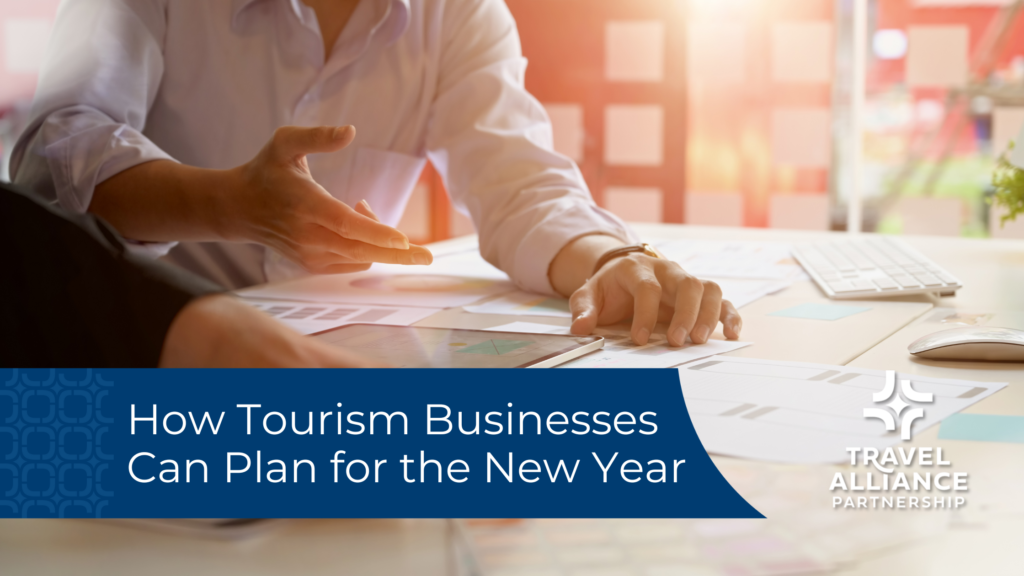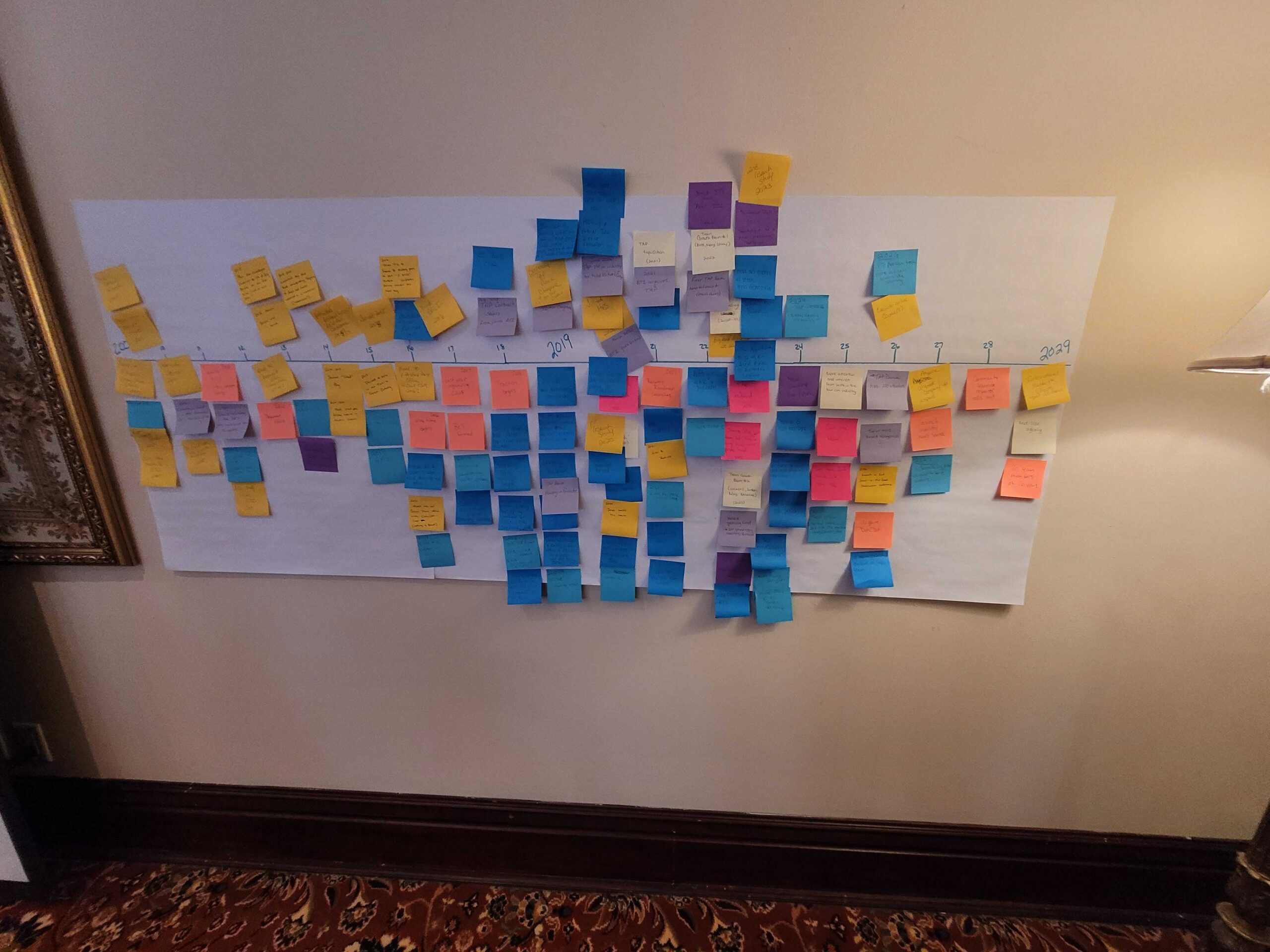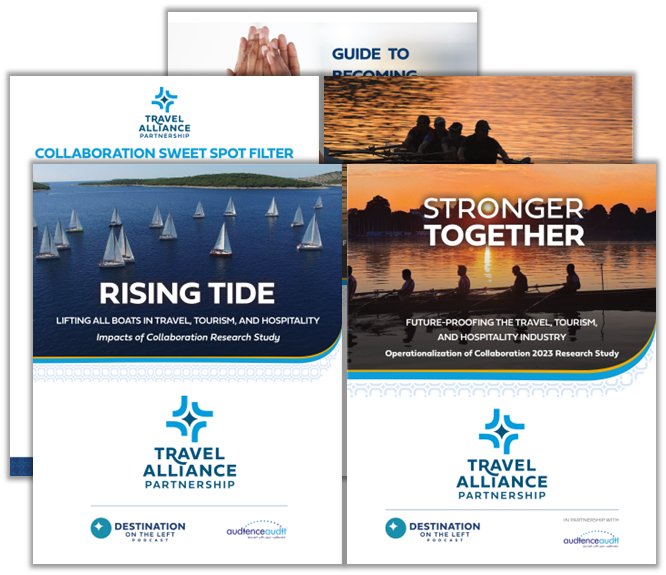How Tourism Businesses Can Plan for the New Year in Collaboration With Staff
A 2024 Tourism Business Plan will set you up for success. I talk to a lot of business owners and organization leaders in the travel, tourism, and hospitality industry. There are always common threads with the conversations and many of these leaders are feeling multiple pressures including:
- The feeling of being time-starved combined with overcapacity and not having the resources needed to achieve their goals.
- Balancing various and sometimes competing priorities.
- Expectations are rising and they are working on expanded programs with fewer people.
- The industry landscape keeps changing and shifting and it is hard to keep up.
- Speaking of goals, sometimes it is hard to articulate goals and other times the goal is clear, but they don’t know how they will achieve it.
- They must maintain higher-than-ever service standards to stay competitive.
- They need to streamline day-to-day operations to do more with fewer resources.
With all these pressures, it is hard to think about creating a 2024 business plan. However, a plan will help address most of the pressures and if done collaboratively with staff, a plan will turn your struggling, overworked organization into a well-oiled machine with everyone on the same page and working towards the same goals.

What should go in your 2024 plan?
Our company follows the Entrepreneurial Operating System (EOS) created by Gino Wickman and detailed in his book Traction. One of the tools in EOS is the Vision Traction Organizer (V/TO), which is essentially a one-page business plan. There are many plan formats that you can chose from, we like this one because it is simplified and easy to update each year.
The elements of our 2024 plan include:
Our core values – these are the guideposts by which we make all decisions. They are what is important to our business and drive the behaviors of everyone within the company.
Our purpose – this is our company mission statement. It explains why we do what we do and inspires everything that our organization does.
Our 5-year target – this is our vision of where we are going. It is written in the present tense, in other words, it describes who we want to be in 5 years. This used to be a 10-year target, but we have found 10 years is too far out to plan in the tourism industry.
Our marketing strategy – this section of our plan is an overview of your marketing strategy, it is not a full marketing plan. This section guides your overall marketing plan and includes:
Our unique point of view – how we stand out from our competition.
What we do – a clear description of what our business does.
Target markets- a list of the audiences and markets we serve.
Brand promise – the experience we deliver in every interaction internal and external.
Our 1-year plan – This is the 2024 plan and should summarize what you will achieve by the end of the year. We include the following:
Future date – December 31, 2024 – placing the actual date on your plan helps keep you focused on the time by which you will achieve the goals you establish.
Revenue goal – this can be a gross revenue goal, gross profit goal, or net profit goal. We break down our goals by revenue category and include an overall net profit number. These are expressed in dollars and not percentages.
Measurables – these are the things that need to happen in order to achieve the goal.
In addition to the V/TO, one organization we belong to offers free planning resources. While these were created for marketing agencies, the tools are relevant for all industries. Check out the resources on this link at Agency Management Institute .
Planning a Strategy Meeting with your team
Engaging your team in the planning process will lead to a more effective and stronger plan. You will be using the power of your organization’s collective brain and experience and if the team is involved in the plan, they are more likely to be successful in executing it and achieving your goals. The way that I engage my team is through an annual strategy planning day. It has become my favorite day of the year and my team looks forward to it too! We spend a full 8 hours working on the business instead of in the business and the results have been meaningful and fruitful.
Here are the key components in our strategy meeting agenda that produce results.
We like to kick off our meetings with everyone answering the same questions. This way, we are all on the same page as we start our day. Focusing on the best news also sets the tone for a positive and forward-thinking day.
Agenda item #1: Meeting expectations
- Best business & personal news in the last 90 days
- What are your expectations for the meeting?
- Is there a problem that you want us to help you solve?
- Do you want to learn something?
- Anything else?
Agenda item #2: 2023 Accomplishments – this section helps the team celebrate the wins and focus on what is working. Everyone answers these questions:
- Personal & Professional
- What did we do well as a company?
- What did you do well personally?
- What enabled the accomplishments?
A volunteer scribes on flip chart paper as everyone shares their input. I do one section at a time, first meeting expectations and then accomplishments.
Agenda item #3: 2023 Business Review – this section can be whatever fits for your organization. We spend time looking at our goals and performance in these areas, then ask for feedback at the end.
- Financials Sales goals
- Marketing metrics
- What key points stand out? /What did I miss?
The next sections of the agenda can vary in order depending on what we are trying to accomplish. If I already have the V/TO or one-page business plan updated from the previous year, I start by reviewing that. If I don’t have the one-page plan done because I need help from the team, we start with some team exercise. Here are a few exercises we have used at recent meetings:
Journey Line Exercise
We used this exercise to achieve the following goals:
- We wanted our longest tenured employees to share the story of our company’s evolution.
- To reflect on the building blocks that have brought us to the present day.
- To create a vision for the next 5 years.
For this exercise, we put flip chart paper on the wall and drew a line through the center. At one end of the line, we wrote the year the company started and on the other end, we wrote the year that is five years from now. For us, the timeline went from 2009 to 2029. Then we ask every employee (new and seasoned) to write down the following on post-it notes.
- Past & Present: Identify key dates/milestones/accomplishments for BTI 2009-2023.
- Future: What will TAP bring to us & the tourism industry? Where do we see ourselves in the future?
- What stands out to you?
Once they finished writing on post-its, they placed their notes on the timeline. At the end of the exercise, we had a discussion and we all felt connected by the collective story this exercise told.

SWOT Exercise
We love to use SWOT (Strengths, Weaknesses, Opportunities & Threats) to help us create our one year and five-year plans. It helps us identify areas for improvement and growth, as well as prepare for what may be coming down the road. In this exercise, I have everyone fill out a SWOT worksheet and I collect them at the end. Note, when doing a SWOT, the strengths and weaknesses are internally focused, while the opportunities and threats are externally focused. This can get tricky for people to understand. Remember that there are no right answers and have fun!
Once the form is filled in, everyone shares their responses, we go through one quadrant at a time and scribe the answers on flip chart paper. After everyone’s thoughts are recorded, we circle any themes that stand out. Then, we answer these questions:
- Where should we focus next year? What are the benefits in moving forward on these areas?
- Is there anything else we need to consider to move closer to our goals?
- What else may we do to move closer to our goals?
Delegation Exercise
We used this exercise with our leadership team to help identify areas where they could find more capacity. Everyone answers the below questions and shares their answers and insights.
- What do you think you have to hold onto?
- What can you let go of?
- Who would you give it to on your team?
- If you do that what capacity does that open up for you?
- How can you use that capacity towards the effective and efficient application of our services?
Superpowers Exercise
This is one of my favorite team building exercises. Everyone has a blank sheet of paper in front of them. Each person writes their name at the top and then they pass the paper to the right. The person to the right then writes a word that describes a superpower that they admire about the person whose name is on the top. Then, the papers get passed to the right again and this continues until everyone in the room has written one word on each person’s paper. This is a great way to recognize everyone’s talents and what they bring to the team. I even did this for my family and then framed each person’s superpowers to provide a constant reminder of what makes them special.
Ending your meeting.
At the end of the meeting, we revisit the flip chart paper from the beginning of the meeting and answer these questions:
- Were your expectations met?
- What stood out to you?
And the last two years, I have added gratitude into our closing. I started this because I personally wanted to improve my gratitude practice, but the response from the team has been amazing and I think we will keep this one for every future meeting. Everyone adds to their closing comments with the following:
- 3 things you are grateful for – use the sentence “I am grateful for…, it makes me feel…”
Feel free to use our agenda format, SWOT worksheet, copy our V/TO format or reach out to me if you have any questions. I believe we are all stronger together and if creating a 2024 tourism business plan makes you a stronger company, it lifts the whole industry up too!
Related Posts
Creating a Strategic Travel and Tourism Marketing Plan: A Step-by-Step Guide
Strategic marketing is about attracting the right people, at the right time, with the right message. A clear, strategic marketing plan is your blueprint for…
What is Accessibility in Tourism?
Travel is an incredibly life-enriching and rewarding experience, yet it is still inaccessible to many people. About 15 percent of the world’s population live with…
